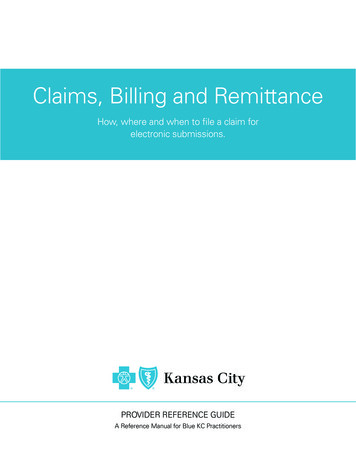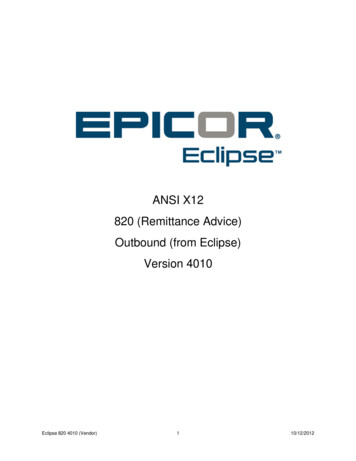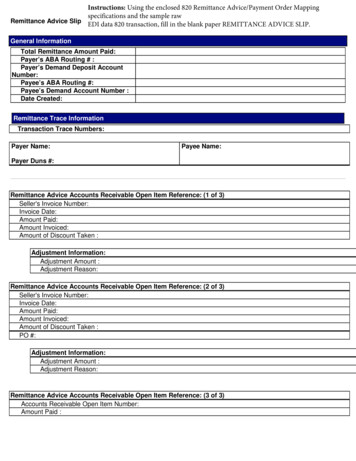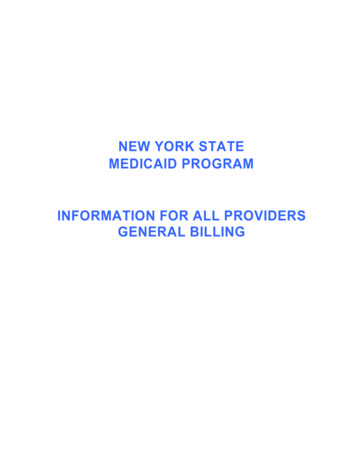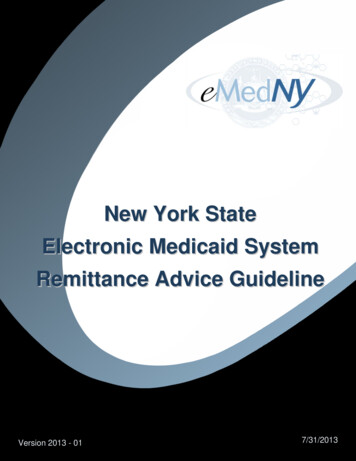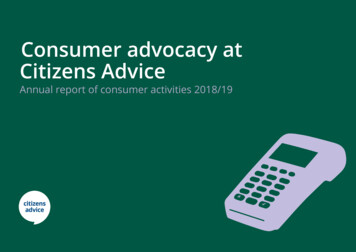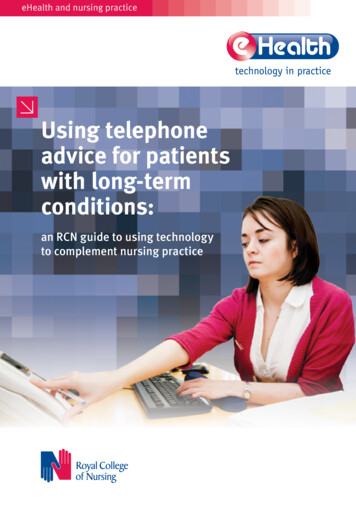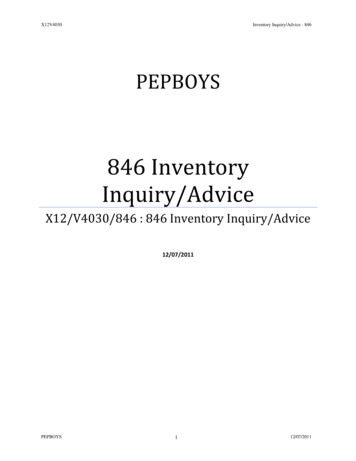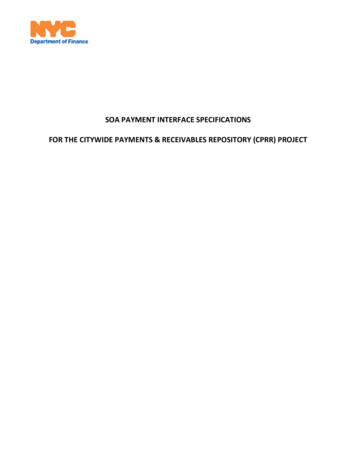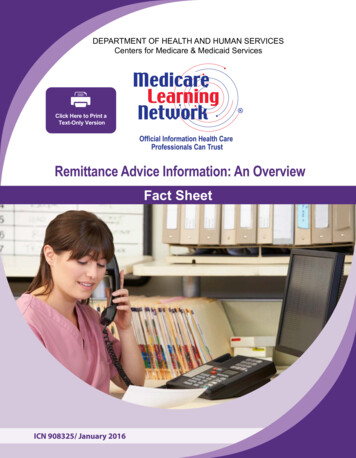
Transcription
DEPARTMENT OF HEALTH AND HUMAN SERVICESCenters for Medicare & Medicaid ServicesClick Here to Print aText-Only VersionRemittance Advice Information: An OverviewFact SheetICN 908325/ January 2016
The Remittance Advice (RA) is a notice of payment sent as a companion to claim payments by MedicareAdministrative Contractors (MACs), including Durable Medical Equipment Medicare Administrative Contractors(DME MACs), to providers, physicians, and suppliers.What Is an RA?When you submit a claim to a MAC, you will receive an RAs that explains the payment and any adjustment(s)made to a payment during Medicare’s adjudication of claims. RAs provide itemized claims processing decisioninformation regarding: Payments; Deductibles and co-pays; Adjustments; Denials; Missing or incorrect data; Refunds; and/or Claims withholding due to Medicare Secondary Payer (MSP) or penalty situations.The RA provides justification for the payment, as well as input to your accounting system/accounts receivable andgeneral ledger applications. The codes in the RA will help you identify any additional action you may need to take.For example, some RA codes may indicate that you need to resubmit the claim with corrected information, whileothers may indicate that you can appeal a payment decision.For more information about RAs visit the Health Care Payment and Remittance Advice web page on theCenters for Medicare & Medicaid Services (CMS) website.What Types of RAs Are Available?MACs send RAs in either an electronic format (Electronic Remittance Advice [ERA]), or a paper format (StandardPaper Remittance Advice [SPR]). Although the information that the twoformats provide is similar, the ERA offers some data and administrativeProviders Must Use EFTefficiencies not available in an SPR. For example, ERAs can be manipulatedAll providers enrolling in theelectronically into a variety of report formats. Further advantages of the ERAMedicare Program for theare listed on page 3.first time, changing existingTo obtain ERAs, or to switch from receiving SPRs to ERAs, you need toenrollment data or revalidatingcontact your MAC to establish Electronic Data Interchange (EDI) capabilitiesenrollment, must use Electronicwith that MAC.Funds Transfer (EFT) to receivepayments. EFT information isERAs are only available electronically to providers for a specified periodavailable on the CMS website.of time after claims adjudication. Your MAC determines the timeframe forRA availability. Therefore, you should confirm the timeline and establishprocesses to download and save ERA data files on a regular basis.MACs do not distribute SPRs if a provider also receives ERAs for more than 31 days (institutional providers) and45 days (professional providers/suppliers). If you submit through a billing service or clearinghouse, or a submitter/sender ID that is currently receiving ERAs, you will no longer receive SPRs effective with the completion of theERA setup date.2
What Are the Benefits of ERA?Using the ERA saves time and increases productivity by providing electronic payment adjustment information that isportable, reusable, retrievable, and storable. Trading partners can exchange the ERA with much greater ease than anSPR. ERA advantages include: Faster communication and payment notification; Faster account reconciliation through electronic posting; Automation of follow-up action; Generation of less paper; Lower operating costs; Ability to create various reports; Ability to search for information on claims; Ability to export data to other applications; More detailed information; and Access to data in a variety of formats through free software supported by Medicare.In addition, an ERA can contain more information than an SPR. For example, an SPR contains two basic pagelayouts: the Claims Page and the Summary Page. However, an ERA contains four page layouts: the All ClaimsScreen, Single Claim Screen, Bill Type Summary Screen, and Provider Payment Screen.Who Receives an RA?MACs send RAs to providers, billers, and sometimes to a provider’s designated financial institution (if the providerenrolled in EDI).Medicare categorizes providers as either accepting or not accepting assignment.Providers that accept assignment receive payment from a MAC for the claims they submitted, as well as an RA.Providers that do not accept assignment must still submit claims to a MAC for services, procedures, or supplies theyfurnish to Medicare beneficiaries. The MAC sends payment for those claims to the beneficiary. The provider receivesan informational RA to report the amount of payment and the adjustments the MAC made to those claims duringadjudication. Providers who do not accept assignment must bill the beneficiary to obtain payment.NOTE: An informational RA is mostly identical to other RAs. However, an informational RA contains a RemittanceAdvice Remark Code (RARC) indicating that the provider does not have appeal rights.NOTE: MACs allow only one receiver of an ERA per National Provider Identifier. Your MAC will contact you if you areset up on its files for multiple receivers of the ERA.How Do I View an RA?Viewing the ERAThe MAC produces the ERA in the Health Insurance Portability and Accountability Act (HIPAA)-compliant AccreditedStandards Committee (ASC) X12N 835 format, often referred to as the ASC X12 835 transaction. The ASC X12 835transaction is for electronic transfers only and the data is not easily readable without a translatorProviders can view and print the information in an ERA using special translator software. For more information onthe Medicare standardized data requirement companion guides for the ASC X12N 835, visit ingEDITrans/index.html on the CMS website.3
Helpful Software for Institutional RAsPC Print software enables institutional providers to print remittance data transmitted by Medicare. MACs arerequired to make PC Print software available to providers for downloading at no charge, although MACs maycharge up to 25 per mailing to recoup costs if the software is sent to providers on a CD/DVD or any other meansat the provider’s request when the software is available for downloading. This software includes self-explanatoryloading and use information for providers. It should not be necessary for you to receive formal provider training touse the PC Print software. MACs must supply providers with PC Print software within 3 weeks of request.MACS are required to supply the PC Print software upon request. Contact information for MACs is available onthe CMS website.Helpful Software for Professional RAsCMS has developed software that gives professional providers/suppliers a tool to view and print an ERA in a userfriendly format. This software is called Medicare Remit Easy Print (MREP). This software is available to providersthrough their respective MACs and/or Common Electronic Data Interchange (CEDI) contractor. The software isupdated three times a year to accommodate the Claim Adjustment Reason Code (CARC) and Remittance AdviceRemark Code (RARC) tri-annual updates, and any applicable enhancements. In addition to these three regularupdates, there is also an annual enhancement update, if needed.The MREP software enables providers to: View and print remittance information on all claims included in the ASC X12 835; View and print remittance information for a single claim; View and print a summary page; and View, print, and export special reports.MREP software has been updated to accommodate ASC X12 835 version 5010.The MREP software is available for download from, the CMS website. Further information on the MREP softwareis also available on the CMS website.What Information Does the RA Include?The RA provides detailed payment information about a health care claim(s) and, if applicable, describes whyMedicare has not paid the total original charges in full. The RA codes help the provider understand the actions theMACs took while processing the claim(s), and to identify any additional action that may be necessary.For example, some RA codes may indicate a need to resubmit a claim with corrected information, while othersmay indicate whether the provider may appeal the payment decision.The RA also features valid codes and specific values that make up the claim payment. Some of these codes mayidentify adjustments. An adjustment refers to any change that relates to how a MAC paid a claim differently thanthe original billing.There are seven general types of adjustments:1. Denied claim;2. Zero payment;3. Partial payment;4. Reduced payment;5. Penalty applied;6. Additional payment; and7. Supplemental payment.4
The RA uses fields to identify areas of a claim and codes to categorize details of the claim. A field may indicatespecific data about the beneficiary, or specific supplies or services the provider rendered. A code represents astandardized reason or condition that relates to the claim or service.The basic elements of the RA can be alphabetic, numeric, or alphanumeric. The HIPAA format standards definethese elements as “Required” or “Situational”. The required fields are mandatory and MACs must include themin every RA. Situational fields depend on data content and context (for example, Medicare requirements for aparticular service).NOTE: The field names may vary depending on the translator software used by the provider.Although several codes may appear on an RA, not all of these codes may appear at the same time. The codes areeither medical or non-medical code sets, as defined below.Medical Code SetsMedical code sets are clinical codes MACs use to identify what procedures, services, supplies, drugs, anddiagnoses pertain to a beneficiary encounter. Professional societies and public health organizations maintainmedical codes that characterize a medical condition or treatment. Some medical code sets are specific to aparticular provider type.The RA includes medical code sets such as: Healthcare Common Procedure Coding System (HCPCS) Level I and Level II Codes; International Classification of Diseases, 10th Revision, Clinical Modification (ICD-10-CM); Current Dental Terminology (CDT) Codes; and National Drug Codes (NDCs).Additional information on the medical codes sets used in RAs is available on the CMS website.Non-Medical Code SetsNon-medical code sets are code sets that characterize a general administrative situation rather than a medicalcondition or service. The non-medical code set descriptions appear below.Group CodesA group code is a code identifying the general category of payment adjustment. A group code is always used inconjunction with a CARC to show liability for amounts not covered by Medicare for a claim or service. For moreinformation on group codes, visit the “Medicare Claims Processing Manual,” Chapter 22 (Remittance Advice),Section 60.1 (Group Codes) on the CMS website.Claim Adjustment Reason Codes (CARCs)CARCs provide financial information about claim decisions. CARCs communicate adjustments the MAC madeand offer explanation when the MAC pays a particular claim or service line differently than what was on the originalclaim. If there is no adjustment to a claim or service line, then there is no need to use a CARC.CARCs are located in the ADJ REASON CODES field on the ERA and the RC field on the SPR.A national health care code committee maintains and updates CARCs three times per year.For a listing of all CARCs and their descriptions, visit http://www.wpc-edi.com/reference/ on the Internet.Remittance Advice Remark Codes (RARCs)RARCs further explain an adjustment or relay informational messages that CARCs cannot express. Additionally,there are some informational RARCs, starting with the word “Alert” that MACs use to provide general adjudicationinformation. These RARCs are not always associated with a CARC when there is no adjustment.MACs can use RARCs at the service-line level or the claim level.5
CMS maintains and updates RARCs three times per year. For a listing of RARCs and their descriptions, visithttp://www.wpc-edi.com/reference/ on the Internet. For more Medicare specifics see the “Medicare ClaimsProcessing Manual” (Chapter 22, section 60.3) on the CMS website.Provider-Level Balance (PLB) ReasonCodesProvider Level Balance (PLB) reason codes describe adjustments the MACs make at the provider level, instead of aspecific claim or service line. Some examples of provider-level adjustments would be: An increase in payment for interest due as a result of late payment of a claim by Medicare; A deduction from payment as a result of prior overpayment; and An increase in payment for any provider incentive plan.The PLB code list is an internal code list. For more information on PLB codes, see MLN Matters article, MM7068,on the CMS website.CARC and RARC Update ScheduleThe Council on Affordable Quality Healthcare (CAQH) Committee on Operating Rules for Information Exchange(CORE) mandated operating rules require the usage of a standardized CARC and RARC combinations whenused on the ASC X12 835 transactions. These combinations are maintained in a list updated three times ayear by CAQH CORE. The complete CARC/RARC code combination list is available at: http://www.caqh.org/CORECodeCombinations.php on the Internet. This website notifies the provider of the following events in the RARCmaintenance process: The Start (or effective date) and Last Modified date of ‘current’ codes; The Start, Last Modified, and planned Stop Date of ‘to be deactivated’ codes; and The Start, Last Modified, and Stop Date of ‘deactivated’ codes.The updated list of CARCs is published three times a year after the committee meets before the ASC X12 trimestermeeting in the months of January/February, June, and September/October. MACs use the latest approved CARCs inERA, SPR, and COB transactions.The RARC list is also updated three times a year, and the list is posted at the WPC website and gets updated atthe same time when the reason code list is updated. Both code lists are updated on or around March 1, July 1, andNovember 1. MACs use the latest approved remark codes. CMS publishes MLN Matters articles whenever CARC/RARC updates are made. Subscribe to the MLN Matters mailing list so you will receive email notice of all new MLNMatters articles, including those announcing CARC/RARC changes.MACs may also alert providers of updated codes through bulletins, appropriate listserv messages, and/or their websites.Requests for Adding, Modifying, or Deactivating CARC and RARC CodesThe maintenance committees that manage the CARC and RARC sets meet three times a year to review all newrequests. To request additional CARCs, or to modify an existing code, visit are/claim-adjustment-reason-codes/ to submit a request. Requests for a new code ormodification of an existing RARC code should be submitted via are/remittance-advice-remark-codes/ on the Internet.Once I Receive an RA, What Do I Do?When you receive an ERA, you may:Post decision and payment information automatically, for individual claims in the RA, to the appropriate beneficiaryaccounts when you are using a compatible provider accounts receivable software application;Identify the reasons for adjustments (denials or payment reductions);Note when an EFT payment issued with the ERA is scheduled for deposit in the provider’s bank account, or arrangefor a deposit of a paper check;6
Submit a secondary electronic claim that incorporates Medicare adjustment and payment for data from the ERA toother health care plans that cover the beneficiary if the ERA does not indicate that Medicare has issued a Coordinationof Benefits (COB) transaction;Payment Recoupment ProcessSubmit a paper secondary claim when appropriate to otherhealth care plans, with an attached print out of the MedicareRAs display information on overpaymentsERA information;Medicare has identified and recouped. MACsbegin recoupment of an overpayment on Day 41Print for specific payment information, as needed, by usingfrom the date of the initial demand letter. Interesttranslation software; andaccrues and assesses on an overpayment ifAvoid future errors by identifying potential problems with theyou have not paid in full by Day 30. Providersway original claims were submitted.may request that recoupment begin prior to DayWhen you receive an SPR, you may:41. Providers who elect this option may avoidpaying interest if the overpayment is recouped Post manually to accounts receivable;in full prior to Day 31. For more information, see Use it to correct any errors that you may havethe “Medicare Financial Management Manual,”encountered during claims processing; and(Chapter 4, Sections 10.1 & 80.2). Bill secondary health care plans that cover thebeneficiary.There are other educational resources available from the Medicare Learning Network . The other products are: Medicare Remit Easy Print Software - This fact sheet is designed to provide education detailing the MedicareRemit Easy Print (MREP) software that enables physicians and suppliers to view and print their remittanceinformation. It includes a basic software overview, the benefits of using electronic remittance information,minimum system requirements, and additional resources available on the Internet. Reading a Professional Remittance Advice - This booklet is designed to provide information outliningprofessional Remittance Advice (RA). It includes screenshots of the RA with an explanation of how to read it. Reading the Institutional Remittance Advice - This booklet is designed to provide education outlining theinstitutional Remittance Advice (RA). It includes screen shots of an institutional RA with an explanation of whatyou will find on each screen.Check out CMS on:Twitter,LinkedIn, YouTube,and FlickrThe Medicare Learning Network Disclaimers are available at http://go.cms.gov/Disclaimer-MLN-Product on the CMS website.The Medicare Learning Network , MLN Connects , and MLN Matters are registered trademarks of the U.S. Department of Health& Human Services (HHS).7
This software is called Medicare Remit Easy Print (MREP). This software is available to providers through their respective MACs and/or Common Electronic Data Interchange (CEDI) contractor. The software is updated three times a year to accommodate the Claim Adjustment Reason Code (CARC) and Remittance Advice
